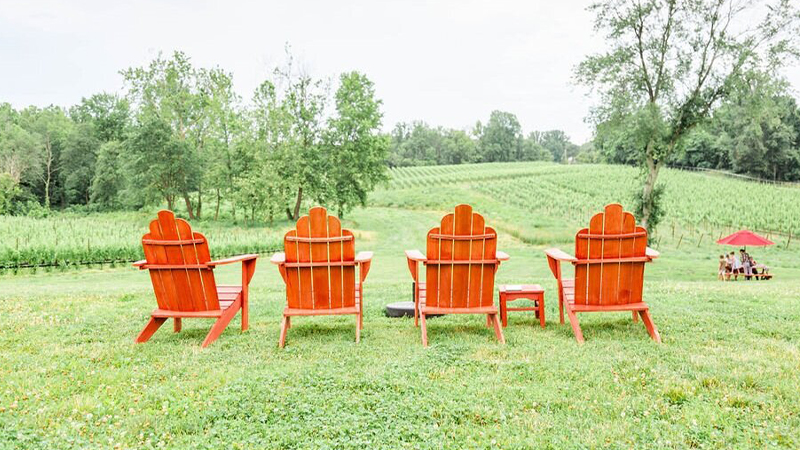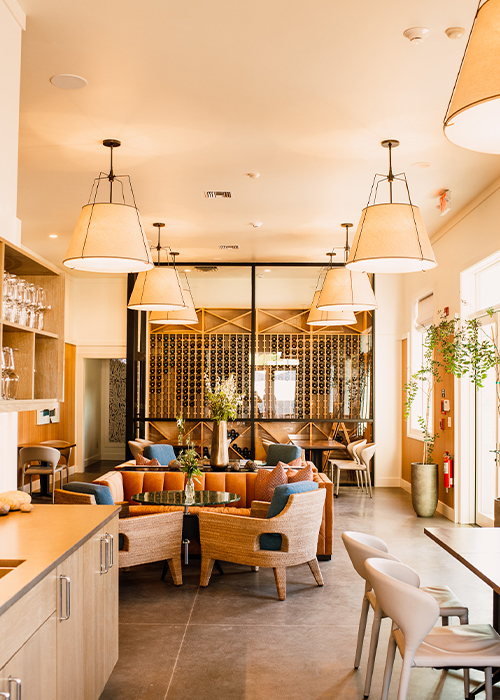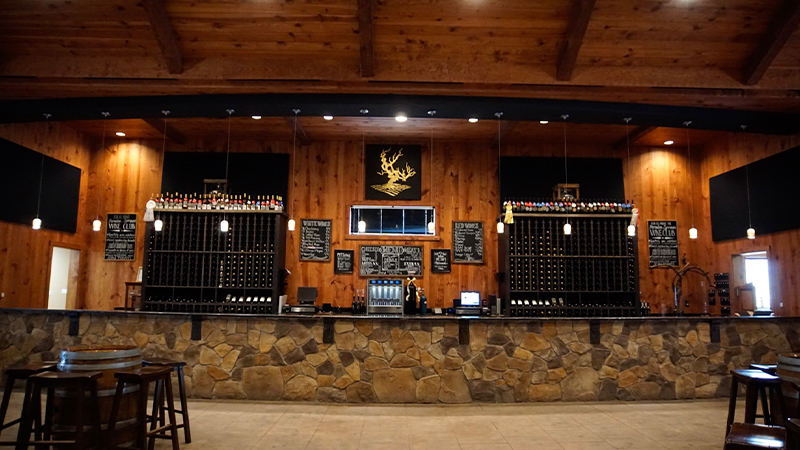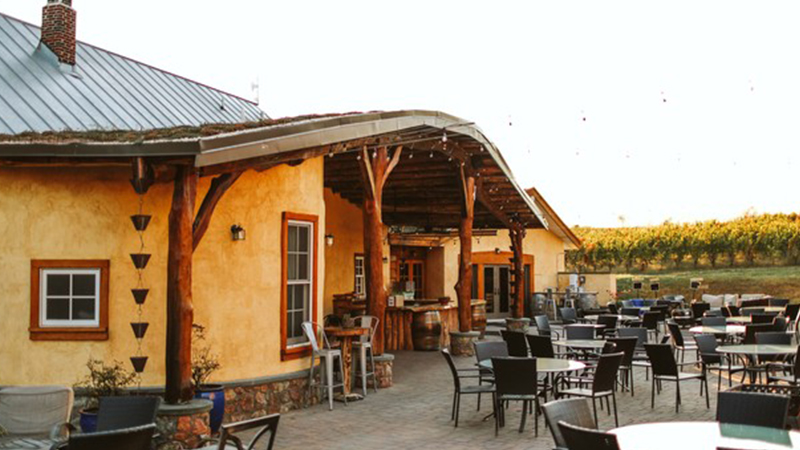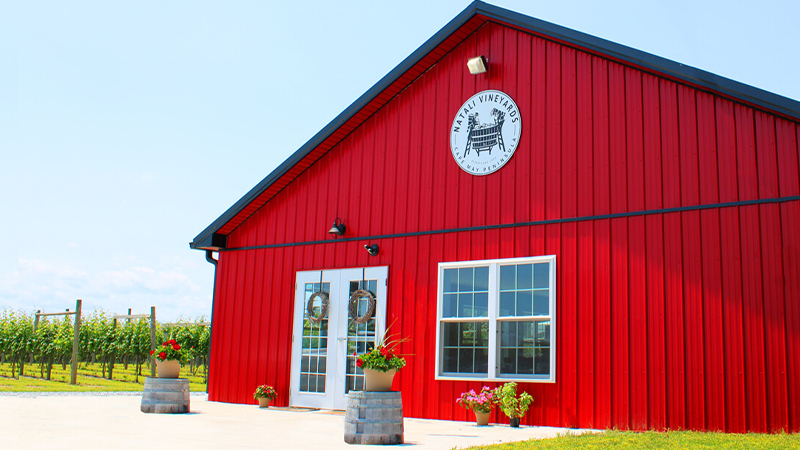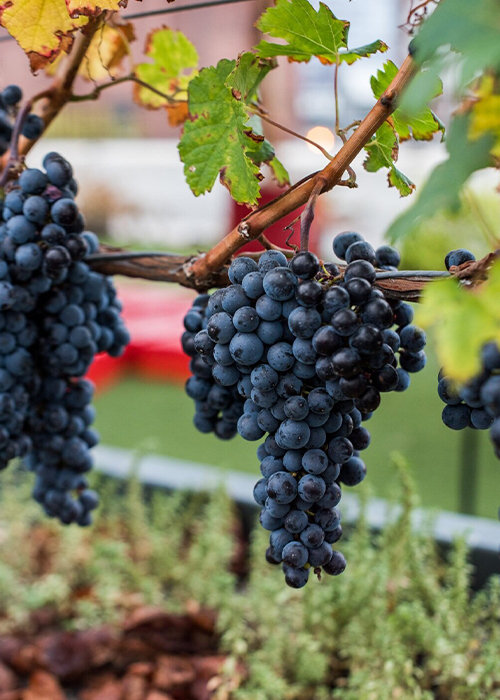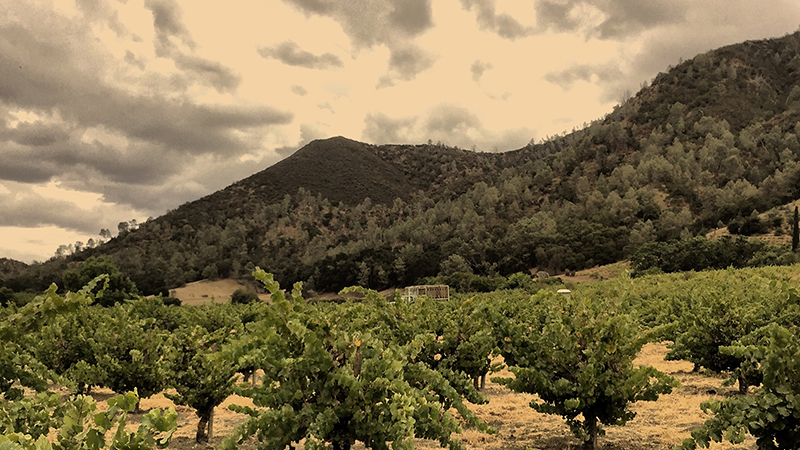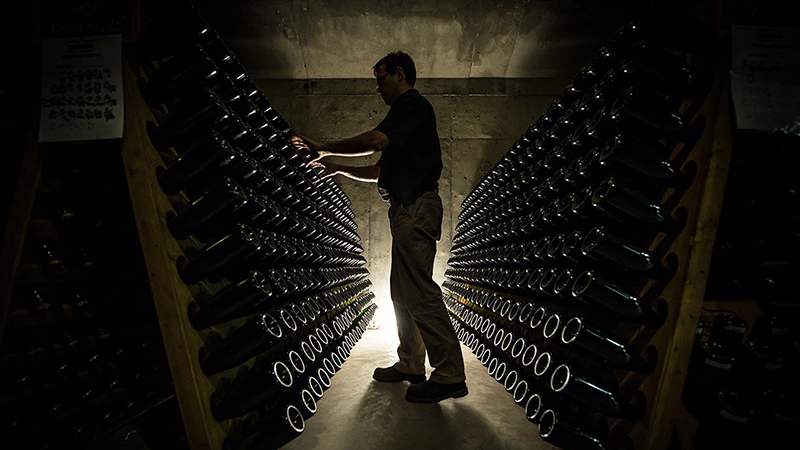All too often, vineyard trips and winery tours are saved for spring and summer vacations. Yet in the United States, on either coast and in regions in between, winery properties and taprooms are seasonless. And with so many — both prominent and hidden — open across the country, the choice of which to visit can be overwhelming, and can require skillful planning.
When faced with such a crossroads, it’s best to turn to the experts. And for this, VinePair turned to the wine pros who live among the country’s diverse AVAs. As professionals of their field, sommeliers have insight into the nation’s wineries that most drinkers don’t — including the best local wineries to visit in their regions.
So, we asked nine sommeliers from across the U.S. what their favorite regional wineries are right now. With varying climates, landscapes, and city-friendly locations, too, these somms lay out the best of their areas to sip, learn, and enjoy American Viticultural Areas. An interesting mix of wineries from New York, California, New Jersey, Maryland, and more are featured here as the top picks from those who know best.
Don’t miss a drop!
Get the latest in beer, wine, and cocktail culture sent straight to your inbox.
The Best Regional Wineries to Visit Recommended by Sommeliers:
- Vineyards at Dodon
- Barboursville Vineyards
- RDV Vineyards
- The Walls
- Kerloo
- Kemmeter
- Paradise Springs
- Michael Shaps winery
- Black Ankle
- Alba vineyard
- Unionville Vineyards
- Natali Vineyards
- Rooftop Reds
- Hermann J. Wiemer
- Stirm Wine Co.
- Littorai
- Illinois Sparkling Co.
- Black Star Farms
- Mari Vineyards
“This is a difficult question to answer because we have great wineries in the area. Some of our great wineries in Virginia are Barboursville Vineyards, which was originally founded by Thomas Jefferson, and RDV Vineyards that produces world-class Bordeaux blends. But my favorite winery to visit at this moment is the Vineyards at Dodon located in Maryland. I love to visit them because of their great hospitality, amazing picnic area, and their fantastic commitment to regenerative agriculture. They also have a sheep herd to help with their regenerative and sustainable practices. Who doesn’t want to enjoy a glass of wine overlooking the vineyards and watching some sheep pastoring?” —Nial Rhys Harris Garcia, beverage director and sommelier, The Conrad Hotel DC, Washington, D.C.
“If you are in the Seattle area, there are plenty of awesome people to meet at SODO Urban Works (go to Kerloo, please), and Woodinville. If you are making the trek east across the Cascades, go all the way to Walla Walla and visit The Walls. They are one of the wineries pushing toward sustainable vineyard practices and finding the best varieties for each site (instead of defaulting to conventionally farmed Cabernet Sauvignon). Check out the concierge tab on their website for a list of more of these forward-thinking properties.” —Nathan Bihm, sommelier, at Canlis Restaurant, Seattle
“I moved to the Bay Area six months ago from the Finger Lakes, and I’ve not yet been out to visit more than two wineries. However, I visited most of the wineries in the Finger Lakes and I can speak to that. The best winery to visit in the Finger Lakes is Kemmeter. Their production is minuscule and you don’t see the wines in distribution or locally in shops. But founder Johannes Reinhardt is from Germany, and worked for winemakers Dr. Konstantin Frank and Anthony Road before starting his own winery. And his Rieslings and Gewurztraminer are some of the best examples of those grapes being produced in the Finger Lakes. Oh, and owner Imelda’s dumplings are legendary.” —Daniel Pendleton, advanced sommelier, Lazy Bear, San Francisco
“Early in the pandemic, getting outside, trying to find new ways to exercise and break the monotony, was key for everyone. For us, hiking became a big part of our weekly routine. We’d try to find new hikes and wineries that were dog friendly and nearby, so we could reward ourselves after the hike. For this reason, Paradise Springs quickly became a favorite. They have wines from Virginia and a partner winery in California, and there is a ton of space to enjoy a glass or two. Their rosé this year was delicious and their reds tend to show some restraint, having a pretty great balance of tannin and fruit. Unfortunately, that secret is out and parking there can be near impossible. So we’ve also ventured further out towards Charlottesville. On a recent getaway there we happened upon Michael Shaps winery, also known as Virginia Wineworks. It’s a custom crush facility where Shaps helps smaller winemakers but also makes his own wine. Additionally, he owns a winery in Burgundy called Maison Shaps and imports wines to his Virginia tasting room. So, you actually get to enjoy both regions and see how he is bringing his Burgundian style to the region. It’s not fancy, but the wines drink pretty darn well.” —Theo Rutherford, sommelier and whiskey expert, Deutsch Family Wine & Spirits, Stamford, Conn.
“The landscapes of Maryland are so charming — from the horse country throughout Baltimore County that is painted with acres of corn fields on the eastern side of the state, to the western edges headed toward Frederick. Near this part of Maryland there is a winery, Black Ankle in Mt. Airy, that’s not far from the wineries of Virginia. Here in this pocket of land, Syrah and Albariño thrive, and are the estate-grown grapes. But Bordeaux grapes such as Cabernet Franc, Cabernet Sauvignon, Malbec, Petit Verdot are cultivated as well. During this time of year the fire pits are available to keep you warm along with the hearty, hickory notes and firm structure of their Syrah. Their Albariño Viejo specifically — which translates to “old” — is a weightier white to savor and pair with the cuisine and festivities just around the corner. For their Syrah, I’d suggest roasted game which will complement the age-worthy wine, while tender poultry, yams, and cornbread stuffing pair beautifully with their complex old-vine Albariño, famously known in Rías Baixas within Galicia, Spain. Cheers to great, local wine and toast to another memorable holiday season with their unique Albariño Viejo and Syrah!” —Nicole Erica, freelance sommelier and Italian wine specialist, of Wine Culture with Nicole, Baltimore
“I feel there is a common misconception about New Jersey wine being sub-par as many wineries tend to focus on the ‘wedding aesthetic’ over quality winemaking. However, there are a handful of wineries with a true thirst for fine wine that I genuinely love visiting. I love the passion at Alba Vineyard in the Warren Hills AVA. Their estate Pinot Noir is of exceptional quality. Even though the vines are still a bit young here, the terroir is mineral rich, and the southern-facing slopes offer an honest representation of terroir that Pinot does so well. Another favorite of mine is Unionville Vineyards in the Delaware Valley AVA. Their Pheasant Hill Chardonnay is incredible. The vineyard is about a quarter-acre of south-facing vines in the high altitudes of the Sourland Mountains, and the soil is rich in red slate and clay, which offers a unique spice similar to that of red slate Rieslings of the Mosel.
“But if I had to choose just one favorite, it would have to be Natali Vineyards in the Cape May Peninsula AVA. They have two wines that will absolutely change the way you think about New Jersey winemaking. The first wine, and I can’t stress this enough, is Albariño, the grape of Cape May. Think coastal saline winds, sandy soils, and hot summers… the way it’s meant to be. Their Albariño is spectacular; crisp citrus, juicy ripe pineapple, white flowers, and salinity combine to near perfection. While it’s worth exploring all the Cape May Albariños, the vineyard management and winemaking at Natali is a step above the rest. The second wine is their Nebbiolo. My hat’s off to them for even attempting the ever-so-fickle Nebbiolo in New Jersey, but they succeeded with much finesse. I’ve had the opportunity to blind [taste] a few colleagues on this and every time, high-quality Barolo is called, no one could believe it was from New Jersey. Their Nebbiolo has a grip and possesses great energy, bright red fruit, wild violets, sappy tar, new leather, and clean minerals. Clearly Natali knows what they are doing both in their vineyards and the cellar. The tasting room is simple and cozy, the staff are passionate and knowledgeable, and most importantly the wine is impeccably made. They do an awesome Tempranillo, a fun little Dolcetto, and a variety of experimental wines made from local fruits. I’m so happy to have found this place.” —Alexander Knechel, sommelier, wine sales manager, Plucky Wines, Bedminster, N.J.
“Living in Brooklyn, I’m grateful to have excellent wineries a short bus or subway ride away! Rooftop Reds in the Brooklyn Navy Yard is an urban vineyard making use of rooftop space to grow Bordeaux varietals and help greenify the city. Aside from their rooftop blend, they offer a list of bottles and wines by the glass from their vineyards in the Finger Lakes. There’s a rare magic to sitting amongst the vines while gazing at the Brooklyn skyline. Make sure to check rooftop availability in the winter, as they are generally closed from December to March. When I need a break from the city, I head to the Finger Lakes to visit Hermann J. Wiemer Vineyard. The staff are welcoming, the tasting room is spacious, and the vineyards are idyllic. I can drink their Dry Riesling all day, but I’m equally enthralled by their sparkling wines, such as the Cuvée Brut. It’s affordable, festive, and layered with toasty brioche flavors from extended lees contact.” —Amy Karasavas, wine educator and founder, That Pour Woman, Brooklyn
“The natural inclination from San Francisco would be to look northward, and while a trip to the likes of Littorai will never disappoint, I’d like to offer a less travelled option. About an hour south of the city, in the Pajaro Valley, you’ll find Stirm Wine Co., one of the most exciting new producers in the region. After stints at Tyler and Lieu Dit, Ryan Stirm founded his own project. Like many young vignerons, he farms vineyards throughout the state, with a particular focus on Riesling. It’s from a palatial estate, but a visit to Stirm offers the chance to glimpse the future of California wine. As a bonus, it’s conveniently located between San Francisco, Santa Cruz, and Monterrey, thus ideally situated for a stop on a weekend-long jaunt. Appointments can be made via their website.” —Joseph DiGrigoli, sommelier, Cotogna, San Francisco
“Living in the middle of Chicago, I am certainly not surrounded by grape vines or great wineries (a lot of breweries yes!). However, you can make a day or weekend trip to some great Midwestern wineries. Illinois Sparkling Co., Utica, Ill., about 90 minutes from Chicago: This is one of those ‘wait, where are you making this?’ kinda winery. In the middle of Illinois, Mark Wenzel is making beautiful, Champagne-method sparkling wines and pet-nats out of American grape varieties such as Marechal Foch, Chardonel, and Chambourcin. Unique wines that are a great find for anyone that digs bubbles. My favorite is the Ombré Brut Rosé — you can almost transport to Champagne through this bubbly. Black Star Farms, Suttons Bay, Mich., about five hours from Chicago [is] such a cool place as it is a winery, bed and breakfast, and a functioning farm. Michigan is known for its aromatic white varieties, inspired by Germany and Alsace, and they also make a fantastic Gamay. Definitely a destination site that you will want to spend some time exploring the grounds beyond the tasting room. Mari Vineyards, Traverse City, Mich., about five hours from Chicago: If you’re a fan of that wacky show ‘Oak Island,’ those guys own this winery. I love the winemaker here, Sean O’Keefe, who grew up as part of the family behind Chateau Grand Traverse. Sean is making some killer wines, including several different Rieslings, which Michigan has started to gain a national reputation for. Mari also produces some great Italian varietal wines, which always grabs my interest. Check out their Ramato (skin-contact) Pinot Grigio and some of their reds, including Sangiovese and some unique Northern Italian grapes like Teroldego and Lagrein.” —Jon McDaniel, sommelier, owner and CEO, Second City Soil, Chicago



